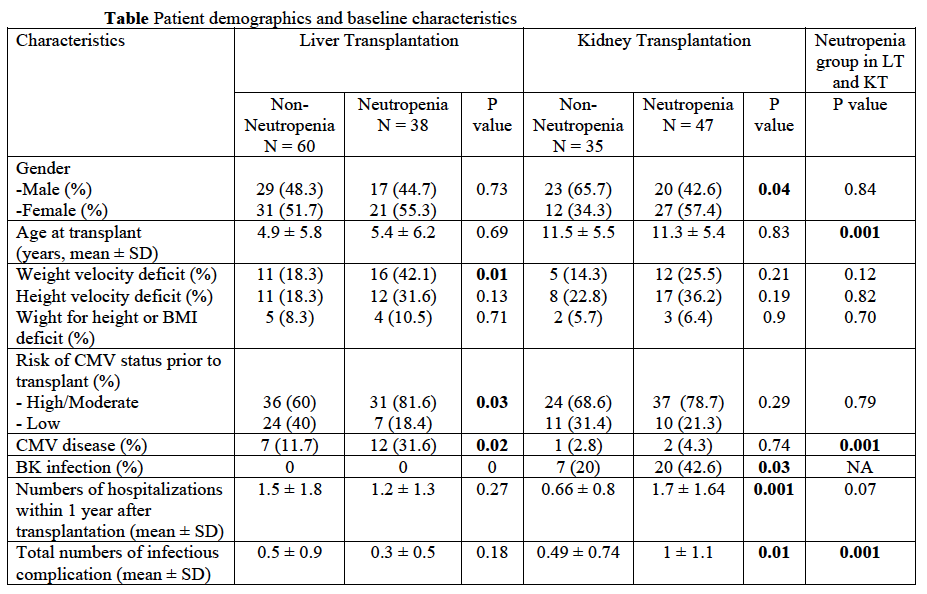Characteristics, Risk Factors, and Outcomes of Neutropenia for the First Year After Liver or Kidney Transplantation in Children
1Pediatric Gastroenterology, Washington University School in St Louis, Saint Louis, MO, 2Pediatric, Washington University School in St Louis, Saint Louis, MO, 3Pediatric Nephrology, Washington University School in St Louis, Saint Louis, MO
Meeting: 2021 American Transplant Congress
Abstract number: 645
Keywords: Kidney/liver transplantation, Neutropenia, Outcome, Pediatric
Topic: Clinical Science » Biomarkers, Immune Assessment and Clinical Outcomes
Session Information
Session Name: Biomarkers, Immune Assessment and Clinical Outcomes
Session Type: Poster Abstract
Session Date & Time: None. Available on demand.
Location: Virtual
*Purpose: Prior studies in adults have shown that approximately 20-38 % of subjects undergoing solid organ transplant develop neutropenia. In the current study, we characterized the incidence, risk factors and morbidity of neutropenia in pediatric (< 18 years at transplant) recipient of liver (LT) and kidney (KT) allografts.
*Methods: We conducted a retrospective chart review of LT and KT recipients at our center during the period 2008-18. All of the KT and none of the LT subjects during this time period had induction with either ATG or basiliximab at time of transplant. Neutropenia was defined as absolute neutrophil count (ANC) value ≤ 1,000/mm3.
*Results: Ninety-eight subjects with LT and 82 subjects with KT were included. Despite the mean ANC being significantly lower in neutropenic LT (3+2.5) subjects compared to neutropenic KT subjects (4.2+2.5) at the time of transplant (p=0.04), the incidence of neutropenia within the first year of transplant in KT (57.3%) was higher compared to LT (38.8%) (p=0.01).The mean number of hospitalizations (p=0.001) and infectious complications (p=0.03) were significantly higher only in the KT subjects who developed neutropenia (compared to those who did not), but not in LT subjects. Binary logistic regression analysis revealed that prior upper gastrointestinal bleed (p=0.03), weight deficit before transplant (p=0.01), CMV infection (p=0.04) and ANC before transplantation (p=0.02) predicted neutropenia in LT subjects, while female gender (p=0.04) and BK virus infection (p=0.04) predicted neutropenia in KT subjects. Surprisingly, the doses of valgancyclovir, mycophenolate and TMP/SMX were not associated with neutropenia in either LT or KT subjects.
*Conclusions: The incidence of, and morbidity associated with neutropenia within 1 year post transplant is higher in KT subjects compared to LT subjects. Factors which indicate more severe liver disease at transplantation and CMV infection after transplantation were associated with neutropenia. Similar to our finding, BK virus infection has been shown by a prior study to be associated with neutropenia.
To cite this abstract in AMA style:
Jarasvaraparn C, Choudhury S, Rusch C, Liss K, Stoll J, Hmiel S, Kulkarni S. Characteristics, Risk Factors, and Outcomes of Neutropenia for the First Year After Liver or Kidney Transplantation in Children [abstract]. Am J Transplant. 2021; 21 (suppl 3). https://atcmeetingabstracts.com/abstract/characteristics-risk-factors-and-outcomes-of-neutropenia-for-the-first-year-after-liver-or-kidney-transplantation-in-children/. Accessed December 26, 2025.« Back to 2021 American Transplant Congress

